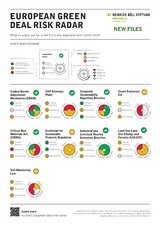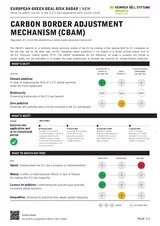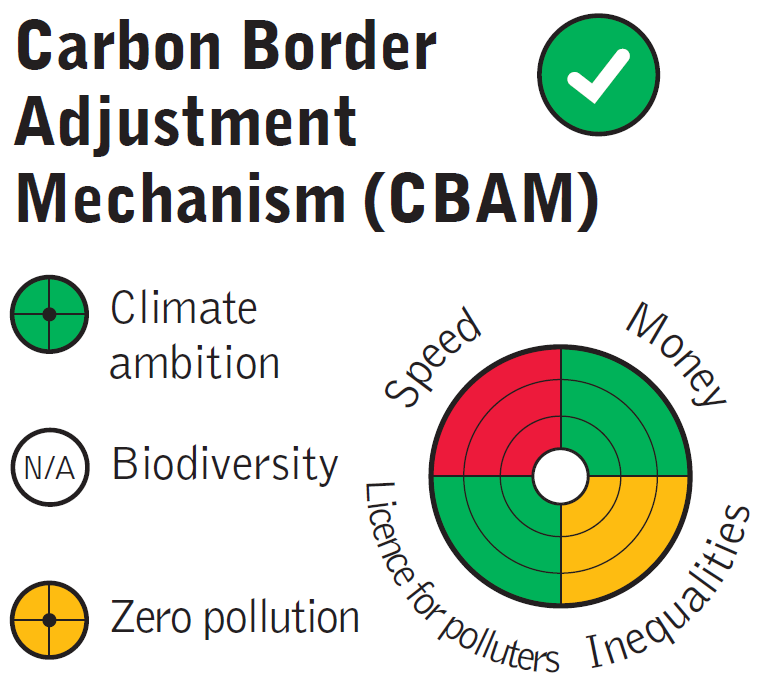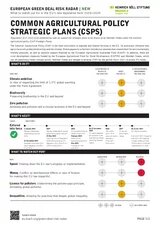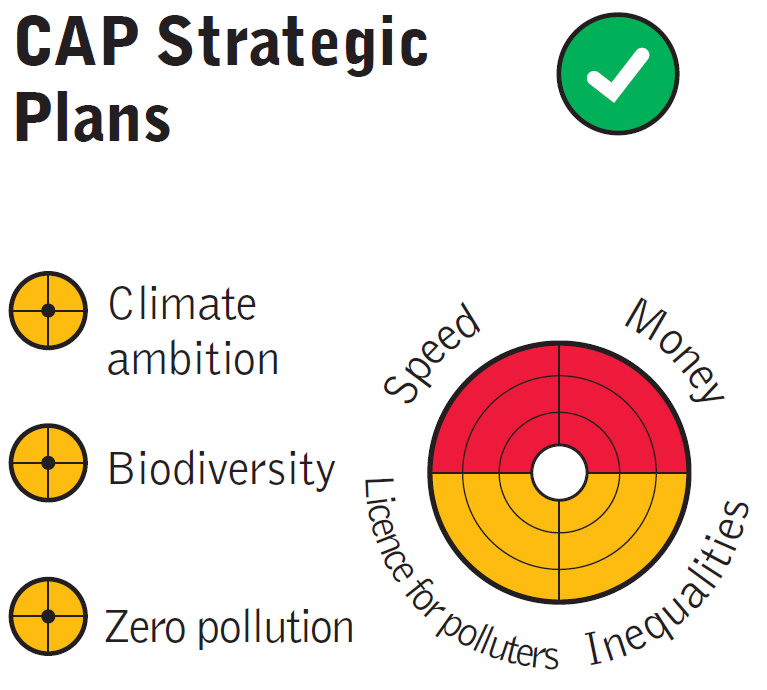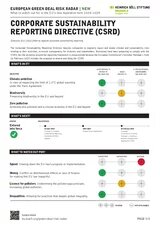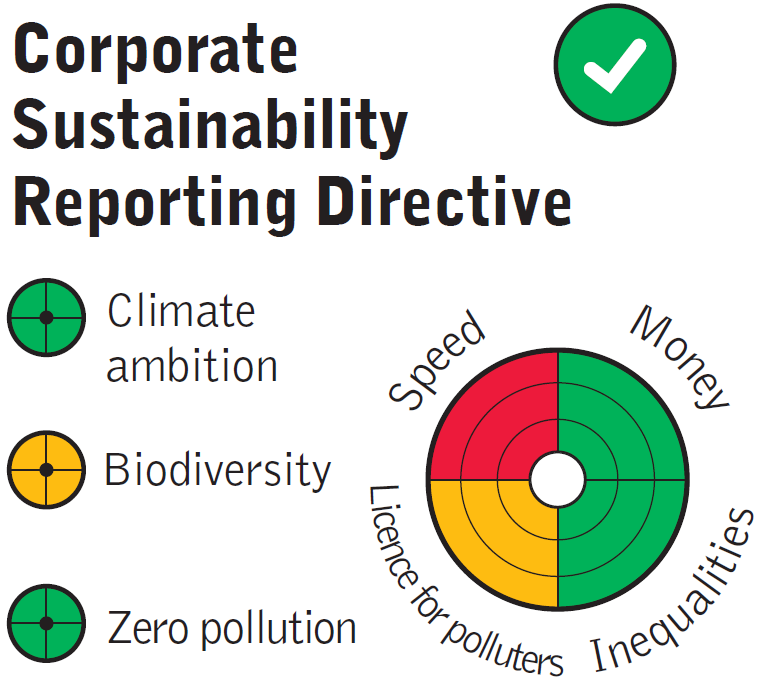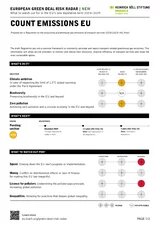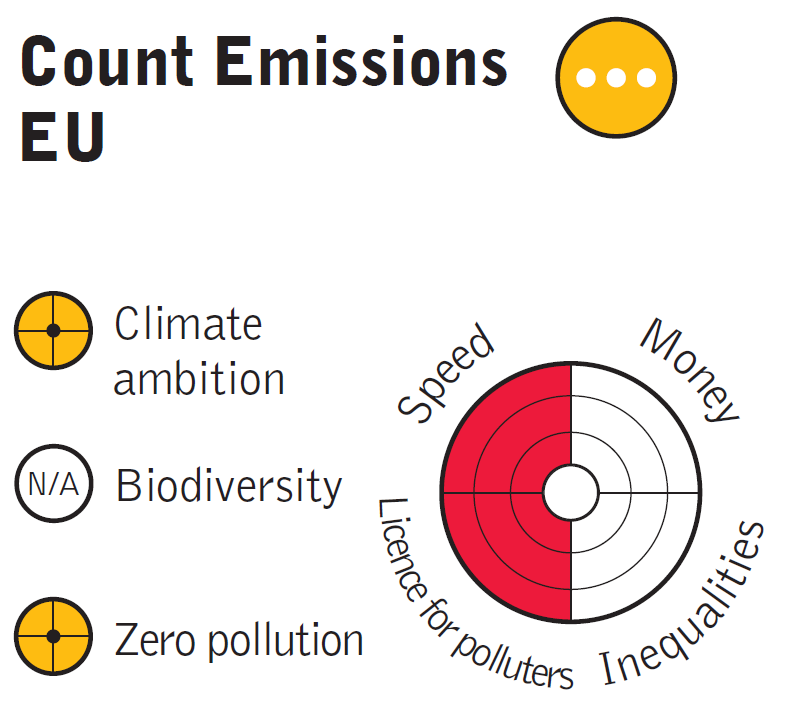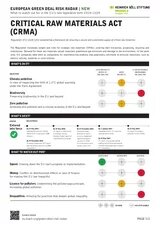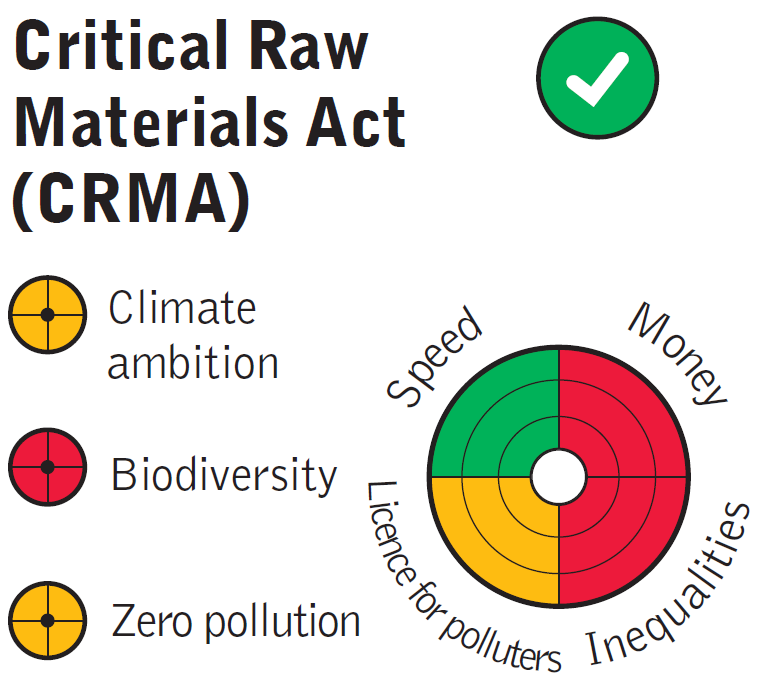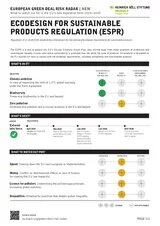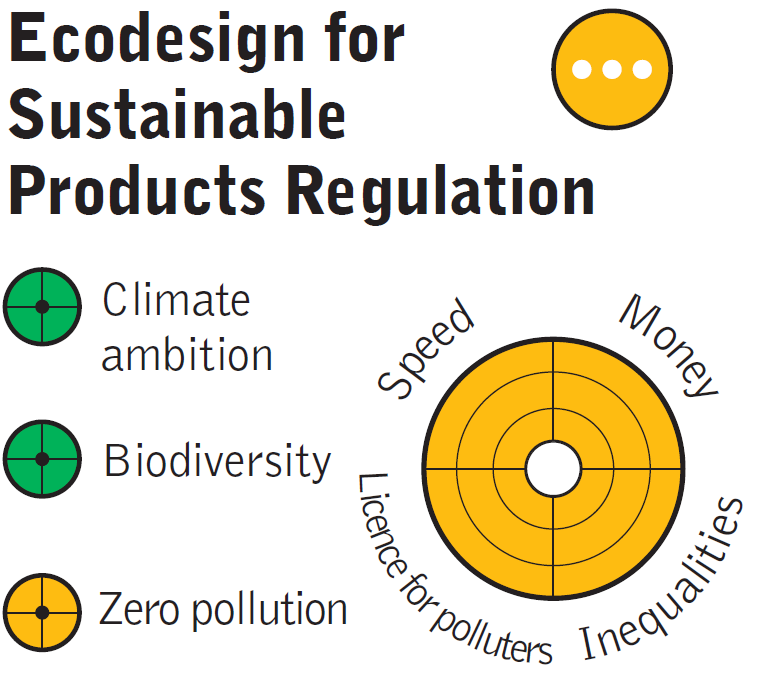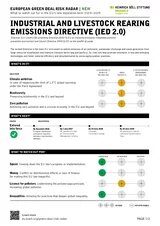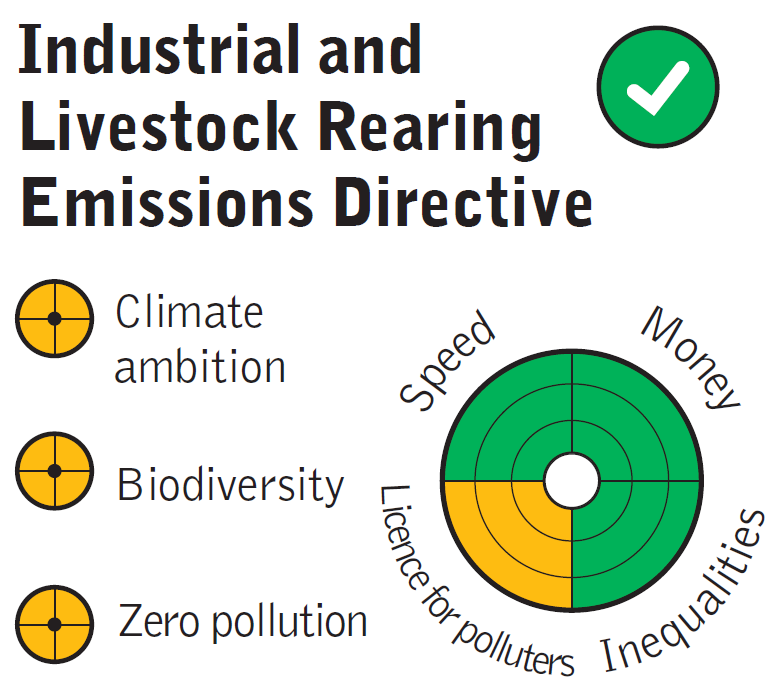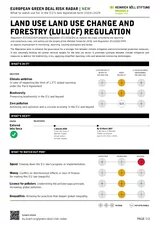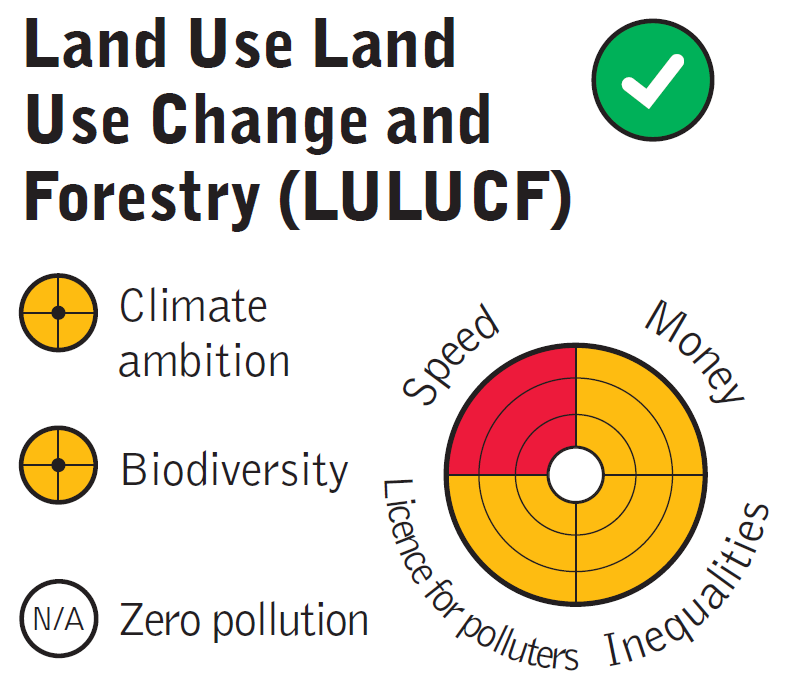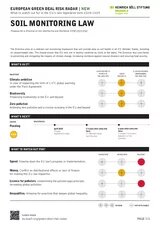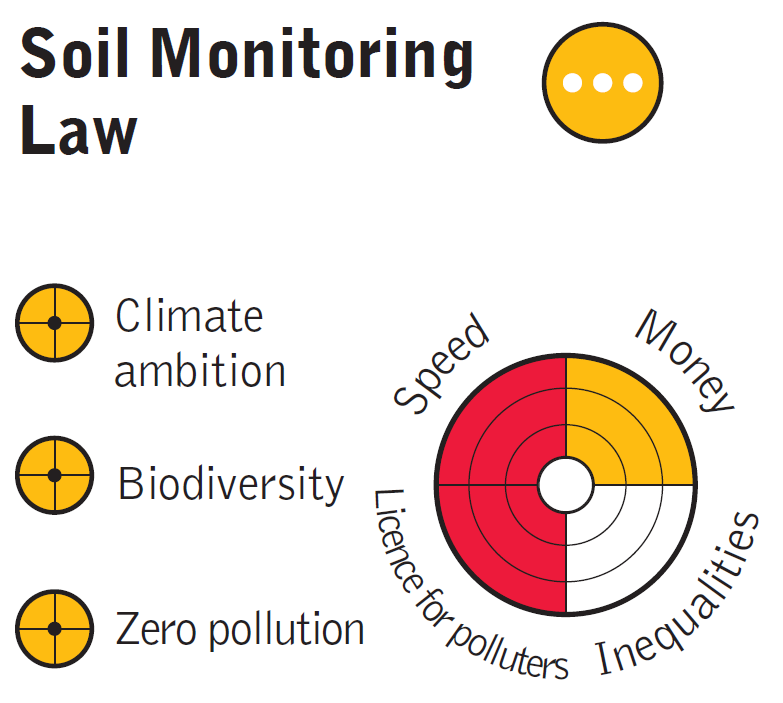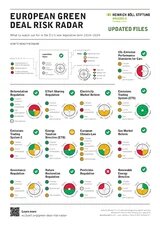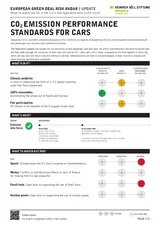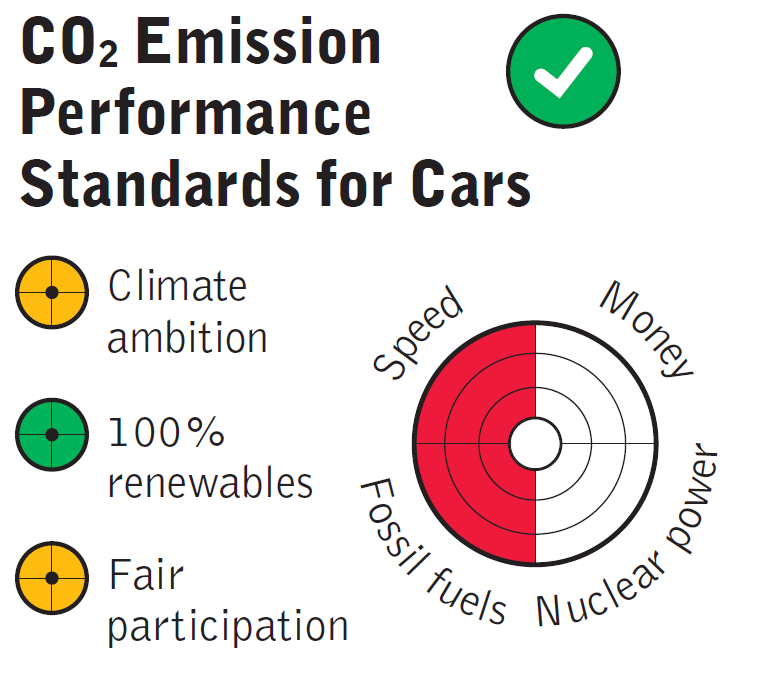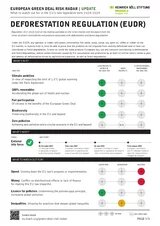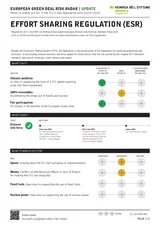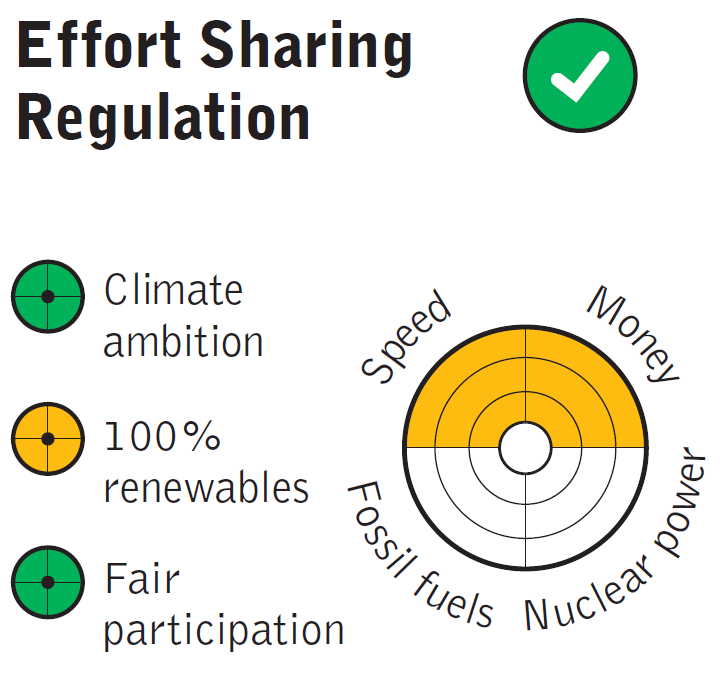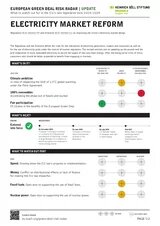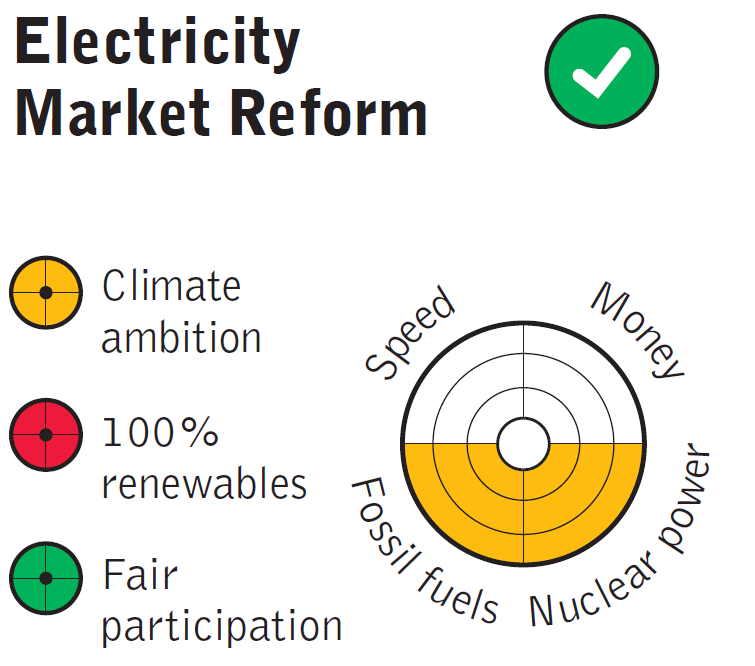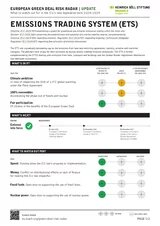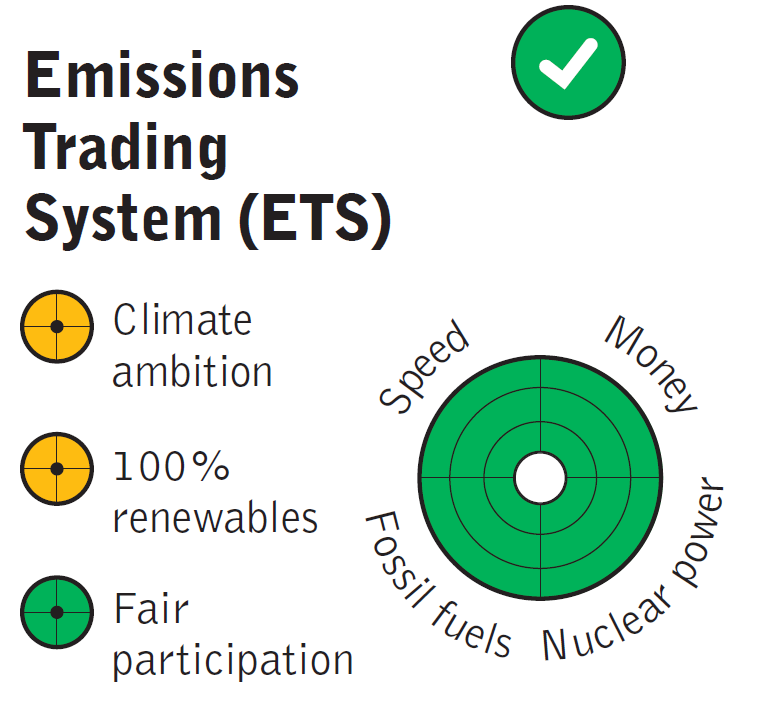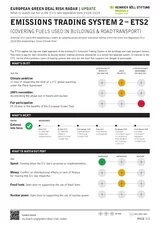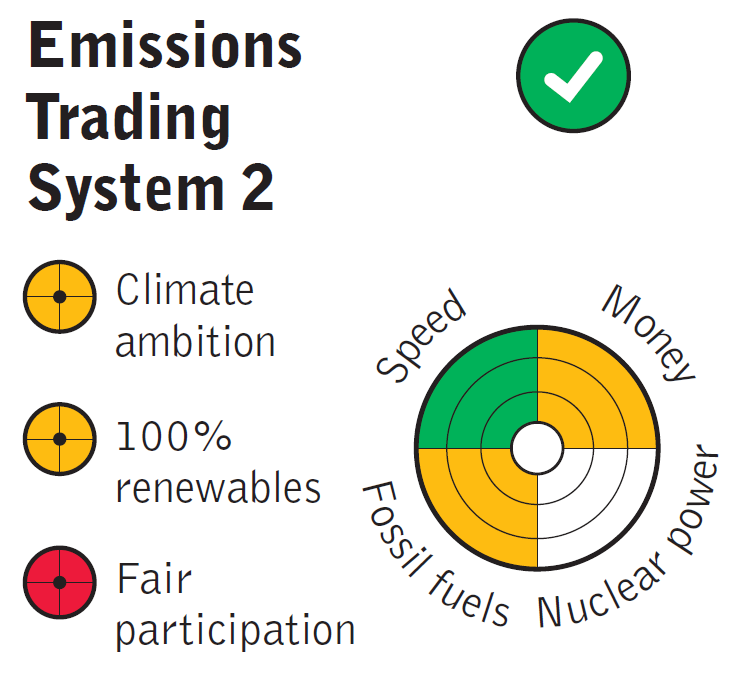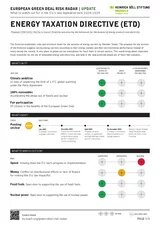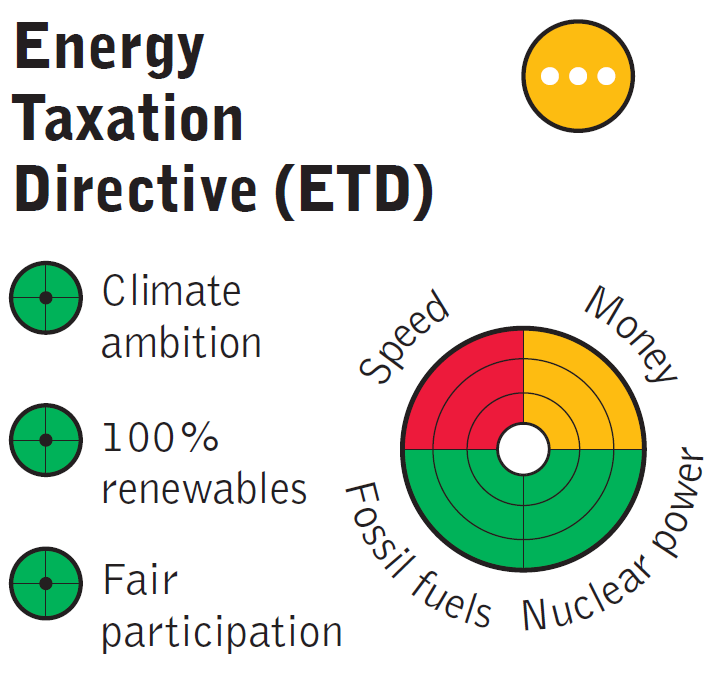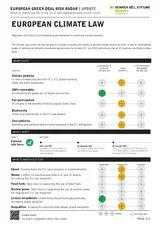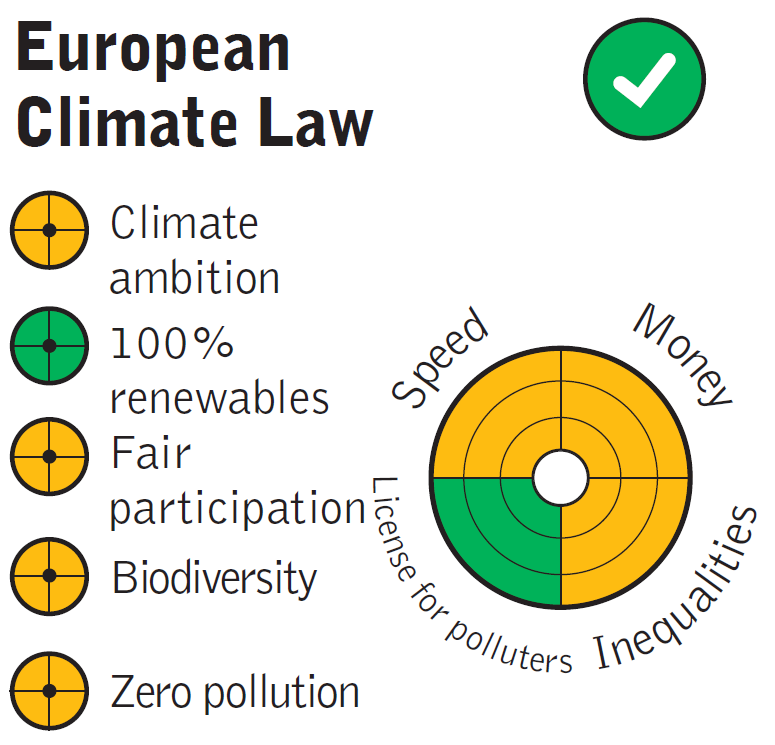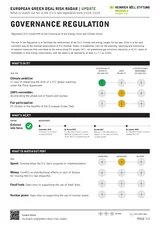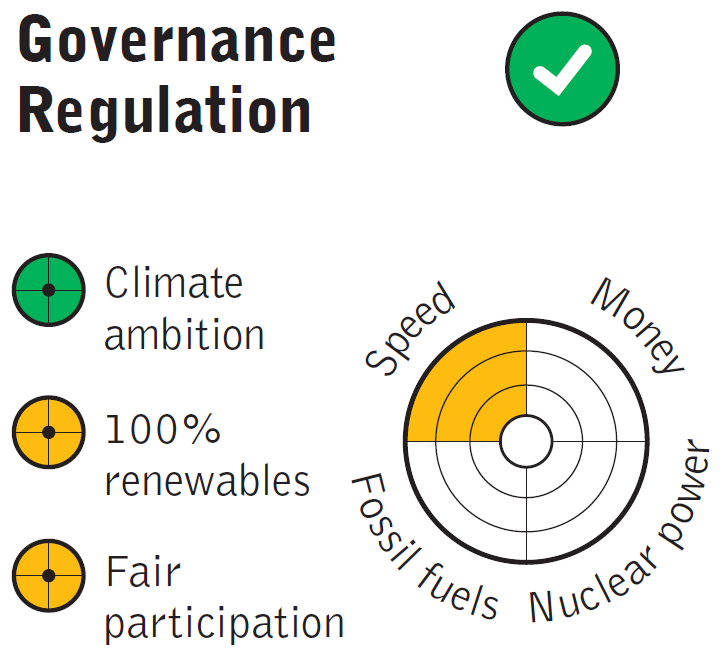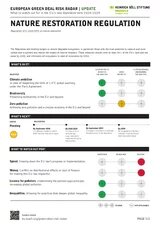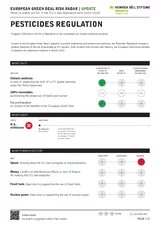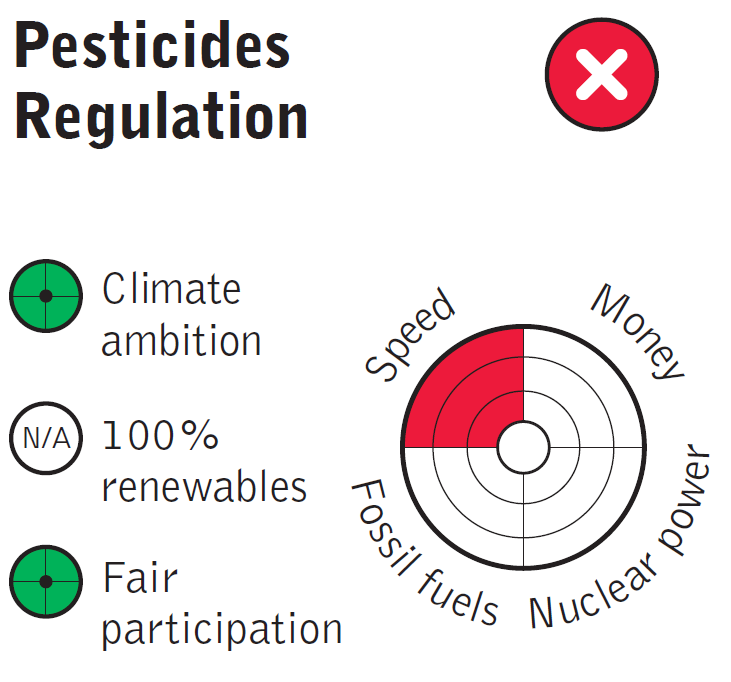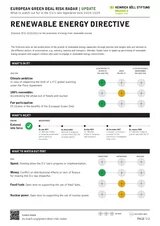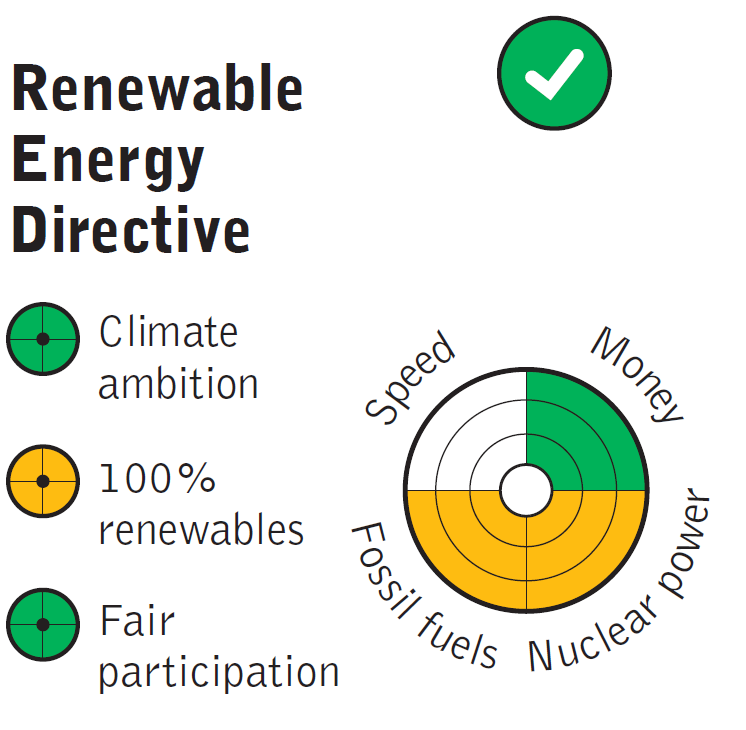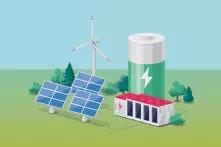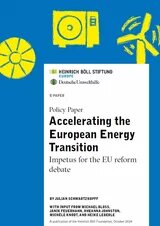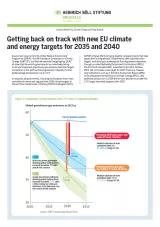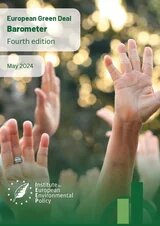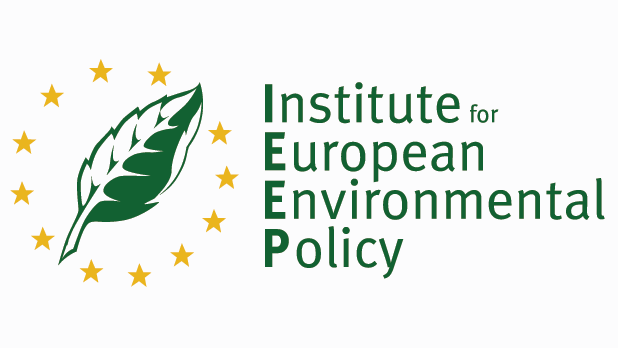Scorecards - UPDATED
European Green Deal Risk Radar
What to watch out for in the new EU legislative cycle
Our European Green Deal Risk Radar analyses the state of play of the most important legislative files of the European Green Deal and identifies the potential risks these laws face in view of being delayed, defunded, undermined, or even withdrawn. It also provides a crucial timeline, highlighting when potential risks are most likely to emerge, be it because of revision clauses, delegated acts, impact assessments or a deadline for transposition into law by EU Member States.
NEW FILES: Carbon Border Adjustment Mechanism (CBAM) | Common Agricultural Policy Strategic Plans (CSPs) | Corporate Sustainability Reporting Directive (CSRD) | Count Emissions EU | Critical Raw Materials Act (CRMA) | Ecodesign for Sustainable Products Regulation (ESPR) | Industrial and Livestock Rearing Emissions Directive (IED 2.0) | Land Use Land Use Change and Forestry (LULUCF) Regulation | Soil Monitoring Law
UPDATED FILES: Overview table | CO₂ emission performance standards for cars | Deforestation Regulation | Effort Sharing Regulation | Electricity Market Reform | Emissions Trading System (ETS) | ETS2 (building & road transport) | Energy Taxation Directive | European Climate Law | Gas Market Reform | Governance Regulation | Nature Restoration Law | Pesticides Regulation | Renewable Energy Directive
Climate ambition under the Clean Industrial Deal: Will our tools work for reaching the targets? - Heinrich-Böll-Stiftung European Union
 Watch on YouTube
Watch on YouTube
NEW European Green Deal/Clean Industrial Deal files to watch out for 🔍
Scorecard
File and description
Risk Radar
Regulation (EU) 2023/956 establishing a carbon border adjustment mechanism.
The CBAM’s objective is to indirectly reduce emissions outside of the EU by creating a level playing field for EU companies on the one side, and on the other side, non-EU companies whose production is not subject to a carbon pricing scheme such as the EU Emission Trading System (ETS). The CBAM compensates for this difference. Its scope is currently still limited to certain goods, but the aspiration is to expand the scope progressively to increase the incentive for climate-friendly production.
Regulation (EU) 2021/2115 establishing rules on support for strategic plans to be drawn up by Member States under the common agricultural policy (CAP Strategic Plans).
The Common Agricultural Policy (CAP) is the main instrument to regulate and finance farming in the EU. Its provisions influence how agriculture will protect biodiversity and the climate. Direct payments to farmers include eco-schemes that reward them for environmentally friendly practices, as well as sectoral support financed by the European Agricultural Guarantee Fund (EAGF). In addition, there are rural development measures funded by the European Agricultural Fund for Rural Development (EAFRD) and Member States, which can all potentially foster climate action. Member States are obliged to develop CSPs for the period 2023–2027 to access EU funds.
Directive (EU) 2022/2464 as regards corporate sustainability reporting.
The Corporate Sustainability Reporting Directive requires companies to regularly report and assess climate and sustainability risks relating to their activities, to ensure transparency for investors and stakeholders. Businesses have been preparing to comply with the CSRD, but the certainty around the reporting framework is compromised because the European Commission’s Omnibus Package 1 from 26 February 2025 includes the proposal to amend and delay the CSRD.
Proposal for a Regulation on the accounting of greenhouse gas emissions of transport services (COM(2023) 441 final).
The draft Regulation sets out a common framework to voluntarily calculate and report transport-related greenhouse gas emissions. This information will allow service providers to monitor and reduce their emissions, improve efficiency of transport services and chose the most sustainable option.
Regulation (EU) 2024/1252 establishing a framework for ensuring a secure and sustainable supply of critical raw materials.
The Regulation introduces targets and rules for strategic raw materials (SRMs), covering their extraction, processing, recycling and substitution. Demand for these raw materials causes important greenhouse gas emissions and damage to the environment. At the same time, EU companies need them as components for manufacturing products that potentially contribute to emission reductions, such as electric vehicles, batteries or wind turbines.
Regulation (EU) 2024/1781 establishing a framework for the setting of ecodesign requirements for sustainable products.
The ESPR is a tool to achieve the EU’s Circular Economy Action Plan, thus moving away from linear processes of production and consumption towards circular ones where sustainability is promoted over the whole life cycle of products. All products to be placed on the EU market will have to comply with the ecodesign requirements, including components and intermediate products.
Directive (EU) 2024/1785 amending Directive 2010/75/EU on industrial emissions (integrated pollution prevention and control) and Council Directive 1999/31/EC on the landfill of waste.
The revised Directive is the main EU instrument to reduce emissions of air pollutants, wastewater discharge and waste generation from large industrial installations and intensive livestock farms (pig and poultry). Its rules will help promote innovation in new and emerging technologies and foster material efficiency and decarbonisation by encouraging greener practices.
Regulation (EU)2023/839 amending Regulation (EU)2018/841 as regards the scope, simplifying the reporting and compliance rules, and setting out the targets of the Member States for 2030, and Regulation (EU)2018/1999 as regards improvement in monitoring, reporting, tracking of progress and review.
The Regulation aims to enhance the governance for a stronger link between climate mitigation and environmental protection measures. It sets nationally binding net carbon removal targets for the land use sector. It promotes synergies between climate mitigation and measures to address the biodiversity crisis, applying simplified reporting rules and advanced monitoring technologies.
Proposal for a Directive on Soil Monitoring and Resilience (COM(2023)416).
The Directive aims at a coherent soil monitoring framework that will provide data on soil health in all EU Member States, including on contaminated sites. This should ensure that EU soils are in healthy condition by 2050 at the latest. The Directive thus contributes to preventing and mitigating the impacts of climate change, increasing resilience against natural disasters and ensuring food security.
UPDATED European Green Deal files to watch our for 🔎
Scorecards
File and description
Risk Radar
Regulation (EU) 2023/851 amending Regulation (EU) 2019/631 as regards strengthening the CO2 emission performance standards for new passenger cars and new light commercial vehicles.
The Regulation updates the targets for CO2 emissions of new passenger cars and vans. By 2030, manufacturers will have to ensure that the fleet-wide average CO2 emissions of their new cars will be 55% (new vans: 50%) lower compared to the limit applied in 2021. By 2035, all new cars will have to be zero-emission vehicles. Manufacturers are free to use technologies of their choice to comply with these emission performance standards.
Regulation (EU) 2023/1115 on the making available on the Union market and the export from the Union of certain commodities and products associated with deforestation and forest degradation.
Under the EUDR, any operator or trader who places commodities like cattle, wood, cocoa, soy, palm oil, coffee or rubber on the EU market, or exports from it, must be able to prove that the products do not originate from recently deforested land or have not contributed to forest degradation. It aims to: avoid the listed products Europeans buy, use and consume contributing to deforestation and forest degradation; reduce carbon emissions caused by EU consumption and production by at least 32 million metric tonnes a year; and address all deforestation driven by agricultural expansion, as well as forest degradation.
Regulation (EU) 2023/857 on binding annual greenhouse gas emission reductions by Member States from 2021 to 2030 contributing to climate action to meet commitments under the Paris Agreement.
Besides the Emissions Trading System (ETS), the Regulation is the second pillar of EU legislation for achieving greenhouse gas emissions. It sets binding national emission reduction targets for those sectors that are not covered by the ETS (domestic transport, agriculture, buildings, small industry and waste).
Regulation (EU) 2024/1747 and Directive (EU) 2024/1711 on improving the Union’s electricity market design.
The Regulation and the Directive define the rules for the interaction of electricity generators, traders and consumers as well as for the use of electricity grids under the control of market regulators. The revised versions aim at speeding up the growth and the grid integration of more renewable electricity to secure the supply of low-cost clean energy. After the energy price crisis of 2022, consumers also should be better protected to benefit from engaging in markets.
Directive (EU) 2023/959 establishing a system for greenhouse gas emission allowance trading and Decision (EU) 2015/1814 concerning the establishment and operation of a market stability reserve; complemented by Directive (EU) 2023/958 (re. aviation), Regulation (EU) 2023/957 (re. shipping), Commission Delegated Regulation (EU) 2024/873 (re. free allocation of emission allowances).
The ETS sets a gradually decreasing cap on the emissions from heat and electricity generation, industry, aviation and maritime transport. The polluters have to pay for their emissions by buying (and/or trading) emission allowances. The ETS is further complemented by the ETS2 dealing with emissions from fuels, transport and buildings and the Carbon Border Adjustment Mechanism (see dedicated scorecards).
Directive (EU) 2023/959 establishing a system for greenhouse gas emission allowance trading within the Union and Regulation (EU) 2023/955 establishing a Social Climate Fund.
The ETS2 applies the cap and trade approach of the existing EU Emissions Trading System to the buildings and road transport sectors. They have to pay for their emissions by buying (and/or trading) emission allowances in a similar but separate system. In contrast to the ETS, not the direct polluters (users of heating systems and cars) but the fossil fuel suppliers are obliged to participate.
Proposal COM(2021) 563 for a Council Directive restructuring the framework for the taxation of energy products and electricity.
The Directive establishes rules and minimum levels for the taxation of energy carriers by Member States. The proposal for the revision of the Directive suggests taxing energy carriers according to their energy content and their environmental performance instead of solely taxing the volume. It also plans to phase out tax exemptions for fossil fuels in certain sectors. This would bring about important fiscal incentives for the use of renewable energy and electricity.
Regulation (EU) 2021/1119 establishing the framework for achieving climate neutrality.
The Climate Law writes into law the goal for Europe’s economy and society to become climate neutral by 2050. It sets an intermediate target of reducing net greenhouse gas emissions by at least 55% by 2030, and ensures that all EU policies contribute to these goals.
Regulation (EU) 2024/1789 and Directive (EU) 2024/1788 on the internal markets for renewable gas, natural gas and hydrogen.
The revision of the existing Regulation and Directive establishes rules for the production, transport and trading of renewable and low-carbon gases. It lays the cornerstone for building and operating a European-wide network of hydrogen pipelines. In parallel, it sets principles for the allocation of the costs of gas infrastructure and protection of gas consumers.
Regulation (EU) 2018/1999 on the Governance of the Energy Union and Climate Action.
The aim of the Regulation is to facilitate the achievement of the EU’s climate and energy targets for the year 2030 in a fair and consistent way with the national governments of EU Member States. It establishes rules for the planning, reporting and monitoring of national measures that contribute to the overarching EU targets (55% net greenhouse gas emissions reduction and 42.5% share of renewables in final energy consumption by 2030).
Regulation (EU) 2024/1991 on nature restoration.
The Regulation sets binding targets to restore degraded ecosystems, in particular those with the most potential to capture and store carbon and to prevent and reduce the impact of natural disasters. These measures should cover at least 20% of the EU’s land and sea areas by 2030, and ultimately all ecosystems in need of restoration by 2050.
Proposal COM(2022) 305 for a Regulation on the sustainable use of plant protection products.
As part of the European Green Deal’s objective to protect biodiversity and achieve zero pollution, the Pesticides Regulation foresaw a gradual reduction of the use of pesticides by EU farmers. After protests from farmers and industry, the European Commission decided to abandon this legislative initiative in March 2025.
Directive (EU) 2023/2413 on the promotion of energy from renewable sources.
The Directive aims at the acceleration of the growth of renewable energy capacities through policies and targets that are tailored to the different sectors of consumption, e.g. industry, heating and transport. Member States have to speed up permitting of renewable energy projects and support citizens who want to engage in renewable energy communities.
Entering the EU’s new policy cycle: The European Green Deal at risk? - Heinrich-Böll-Stiftung European Union
 Watch on YouTube
Watch on YouTube

